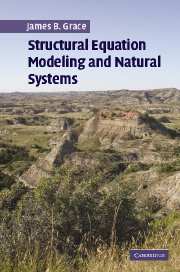Book contents
- Frontmatter
- Contents
- Preface
- Acknowledgments
- PART I A BEGINNING
- PART II BASIC PRINCIPLES OF STRUCTURAL EQUATION MODELING
- 3 The anatomy of models I: observed variable models
- 4 The anatomy of models II: latent variables
- 5 Principles of estimation and model assessment
- PART III ADVANCED TOPICS
- PART IV APPLICATIONS AND ILLUSTRATIONS
- PART V THE IMPLICATIONS OF STRUCTURAL EQUATION MODELING FOR THE STUDY OF NATURAL SYSTEMS
- Appendix I Example analyses
- References
- Index
5 - Principles of estimation and model assessment
Published online by Cambridge University Press: 04 December 2009
- Frontmatter
- Contents
- Preface
- Acknowledgments
- PART I A BEGINNING
- PART II BASIC PRINCIPLES OF STRUCTURAL EQUATION MODELING
- 3 The anatomy of models I: observed variable models
- 4 The anatomy of models II: latent variables
- 5 Principles of estimation and model assessment
- PART III ADVANCED TOPICS
- PART IV APPLICATIONS AND ILLUSTRATIONS
- PART V THE IMPLICATIONS OF STRUCTURAL EQUATION MODELING FOR THE STUDY OF NATURAL SYSTEMS
- Appendix I Example analyses
- References
- Index
Summary
Introduction
In previous chapters, I have presented structural equation model parameters, such as path coefficients, and we have considered their interpretation. Regression equations have been presented to help the reader understand the meaning of parameters and how they are commonly expressed. However, we have not yet considered the important question of how parameter values are estimated. Since we are dealing with the solution of complex multi equational systems, this is not a minor matter.
Historically, path models were solved primarily by the use of the familiar technique of least squares regression (also referred to as ordinary least squares, OLS). Today, most applications of SEM rely on model fitting programs that offer a variety of options for estimation methods, as well as many other supporting features. In this chapter our emphasis will be on maximum likelihood estimation, both because of its central role in the synthetic development of modern SEM, and because it provides a means of solving nonrecursive and latent variable models.
Another important issue that is related to the topic of estimation has to do with the assessment of model fit. One of the most powerful features of SEM is that techniques exist for comparing the observed relations in data to those expected based on the structure of the model and the estimated parameters. The degree to which the data match the model-derived expectations provides us with the capability of evaluating the overall suitability of a model.
- Type
- Chapter
- Information
- Structural Equation Modeling and Natural Systems , pp. 115 - 140Publisher: Cambridge University PressPrint publication year: 2006



